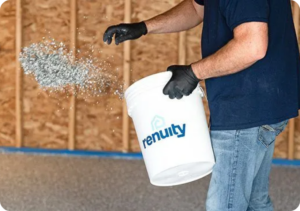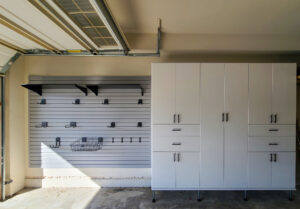Mold thrives in humid environments. Unsurprisingly, it spreads in the garage in a blink of an eye. Apart from being a visual eyesore, it poses considerable health risks. Have you been dealing with a stuffy nose, sore throat, excessive coughing, and itchy red eyes without a clear reason for such health deterioration? There might be mold spores involved here.
Plus, while black mold in a garage is a typical concern for many, a few act promptly to nip the issue in the bud and prevent it from ruining not only the structural integrity of your belongings but also your health. Read on to learn what causes mold in a garage, key signs to look out for, prevention tips, and more.
Common Signs of Mold in the Garage
Mold feeds on organic matter and can grow anywhere in a garage. Yet, it especially loves warm, moist spots in the corners, behind the furniture, and on the damp walls and ceilings. Watch for the following signs to identify mold in the garage promptly and prevent it from taking over your space.
- Damp, musty smell: A strong earthy odor is one of the key signs. Even if you can’t see any mold colonies since they often hide in walls or crawl spaces, it’s crucial to consider the possibility of your area being contaminated.
- Visible spots: Unsightly spots on your garage walls, ceiling, and furniture should make you concerned. Dark discoloration and a thin, slimy layer of gray and black spots are clear signs of fungal growth.
- Allergic reactions: Your immune system doesn’t tolerate fungus and gives clear warning signs you shouldn’t ignore. Respiratory symptoms like wheezing and tightness in the chest areas, excessive coughing, stuffy nose, and eye irritation should make you more vigilant.
Causes of Mold Growth in Garages
Most garages have perfect conditions for fungi to spread, with humidity being the primary stimulating factor. Yet, high humidity doesn’t appear out of nowhere — it’s often the consequence of some of the issues below.
- Leaky plumbing, roofs, and increased condensation: Water damage from leaking pipes and garage roofs increases moisture levels in your space. The same goes for condensation. Differences between the indoor and outdoor temperatures cause the water vapor to liquify and drip onto the surrounding surfaces, creating a perfect breeding ground.
- Blocked drainage system: A compromised drainage system means the water accumulates in the area and further increases humidity.
- Presence of organic material: Mold feeds on organic matter. Wood beams, drywall, and furniture in your garage make it a perfect target.
- Obscured natural light: Lack of natural light makes the area even more susceptive to mold contamination.
Prevention Tips for Mold in the Garage
Searching for effective mold removal tips to keep your home fresh and fungus-free? Keep reading for practical solutions to eliminate mold and restore your peace of mind.
Improving Garage Ventilation
Ventilation is key for effective garage humidity control. Install a sufficient ventilation system in your space to maintain a stable indoor temperature and reduce condensation. Alternatively, opt for exhaust fans to prevent humid air from being trapped in the room. Remember to open doors and windows regularly for natural air circulation.
Controlling Humidity Levels
Consider installing a dehumidifier for a more manageable control of humidity level. This device will be integral for a sustainable garage mold prevention approach, as it helps eliminate excess moisture from the air.

Applying Polyurea Coatings for Mold Resistance
Consider applying polyurea coatings to your garage floor as an effective mold prevention measure. These durable coatings create a moisture-resistant barrier, significantly reducing mold growth by preventing water and humidity from penetrating the concrete surface. Polyurea’s seamless and non-porous finish ensures your garage remains clean, dry, and mold-free.

Proper Storage and Organization
Opt for mold-resistant garage materials when upgrading your storage system. Switch cardboard boxes to plastic containers. Ensure no items susceptible to breeding mold are lying on the floor. Keep a slight gap between the furniture and the wall to allow airflow.
Achieving optimal storage while also aiming to prevent mold might get tricky. If you need expert guidance on garage storage organization and renovation, contact Renuity Home for assistance!
Regular Inspections and Maintenance
Eliminating mold from a garage is a matter of prompt actions and regular upkeep. Inspect your space at least once a month for garage mold prevention. The issue spreads fast and results in structural damage and health risks that won’t go unnoticed. That’s why tackling the issue promptly is the best way to go.
How to Remove Mold in a Garage
It’s generally safe to perform DIY mold removal only if you’re addressing small, isolated mold spots (less than about 10 square feet). Always wear protective equipment—such as gloves, a mask (N95 or better), and safety goggles—and use suitable mold removal products.
However, if you’re dealing with large-scale mold growth, mold from sewage or floodwater, or mold affecting structural areas or HVAC systems, professional remediation is strongly recommended to prevent health risks and ensure the problem is fully resolved.
DIY Removal Methods
If you prefer tackling the issue by yourself, start by examining the room carefully. Start by identifying all the affected areas. Prepare a homemade cleaning concoction by mixing a teaspoon of baking soda with two cups of water. Then, spread the solution and use a brush to give the area a good scrub. Finally, clean the spot with a clean, wet cloth. If necessary, repeat the procedure.
Call a Professional
Working with a professional cleaning service ensures your mold issues are handled quickly, thoroughly, and safely. Professionals come fully equipped with specialized tools and industry-grade cleaning products that are often unavailable to homeowners. Hiring a skilled cleaning team saves you the hassle of buying supplies and preparing cleaning solutions yourself. Plus, you gain peace of mind knowing your project is in expert hands—making professional cleaning an effective, stress-free solution.
Frequently Asked Questions
Is black mold in the garage dangerous?
Yes, black mold in the garage affects your health. It leads to a stuffy nose, sore throat, excessive coughing, and itchy red eyes, among other allergic reactions. People with asthma are at an even higher risk of health deterioration if living spaces are contaminated with mold.
Can mold in the garage spread to my house?
Mold in the garage can easily spread to other areas of your house, making it even more challenging to address the issue. With humid environments being an optimal breeding ground, the garage is one of the first areas in your home to get affected. That’s why handling mold in the garage should be a priority for homeowners.
How to detect mold in a garage?
Look for growing areas of dark, slimy spots creeping across the ceiling, walls, furniture, and corners of the room. Pay attention to the odor in the room — a rusty, earthy smell shouldn’t go unaddressed. Finally, consider how you’ve been feeling lately: coughing, sneezing, and experiencing inexplicable chest tightness are common for residents of homes affected by mold.
How often should I inspect my garage for mold?
Inspect your garage at least once a month for garage mold prevention. Mold tends to spread quickly, leading to structural damage and health risks. That’s why identifying the issue and addressing it as soon as possible is the best solution.
How do I prevent mold in my garage?
The best approach to garage mold prevention is keeping the humidity of your garage space within a normal range. The most straightforward way is to ventilate the space by opening doors and windows regularly. For more controlled ventilation, consider installing vent systems, exhaust fans, and dehumidifiers.

As a content manager at Renuity, Francheska spent nearly two years helping homeowners discover the possibilities of transforming their spaces. Renuity is a leader in home remodeling, specializing in everything from windows and doors to bathrooms and home storage solutions, and she’s proud to be part of a team that prioritizes quality, innovation, and customer satisfaction. She graduated from Florida International University with a double major in International Business and Marketing, ranked among the top programs in the nation. Her passion for home improvement runs deep—since childhood, she’s been inspired by watching HGTV and seeing the magic of remodels come to life. Now, she channels that passion into connecting readers with ideas, tips, and solutions to create homes they love.


